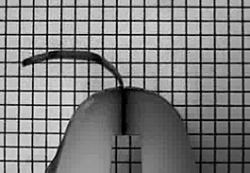Apr 30 2010
Using neutron beams and atomic-force microscopes, a team of university researchers working with the National Institute of Standards and Technology (NIST) may have resolved a 10-year-old question about an exotic class of "artificial muscles"—how do they work? Their results could influence the design of future specialized robotic tools.
 Flexing muscle: IPMC actuator bending under an applied electrical voltage. As the polarity of the 3-volt potential is switched, the actuator bends back and forth.
Flexing muscle: IPMC actuator bending under an applied electrical voltage. As the polarity of the 3-volt potential is switched, the actuator bends back and forth.
These "artificial muscles," first demonstrated in the early 1990s, are "ionic polymer metal composite" (IPMC) actuators, a thin polymer strip plated on both surfaces with conducting metal. The basic unit of the polymer molecule has a charged component attached to it (hence, "ionic"), and it forms a sort of open, permeable structure that can be soaked with water molecules and oppositely charged ions. A modest electric charge across the metalized surfaces will cause the strip to flex in one direction; an alternating charge will make it wiggle like a fish's tail. But why?
"There has been a lot of debate as to the mechanism of actuation in these kinds of systems," says NIST materials scientist Kirt Page. One possibility was that the electric charge on the metalized faces causes the polymer and the free ions to reorient themselves next to the metal, stretching one side and contracting the other. But using a neutron beam at the NIST Center for Neutron Research (NCNR) to watch an IPMC in action as it wiggled back and forth, the team found something very different. Neutrons are particularly good for mapping the locations of water molecules, and they showed that a major force in the actuator is hydraulics. "The water and ions move to one electrode swelling one side and dehydrating the other, causing that to contract, and it bends in that direction," explains Virginia Tech professor Robert Moore, who directed the research. "Then you flip the potential, the ions come screaming back—positive ions again moving towards the new negative electrode—and you can go back and forth."
It happens surprisingly fast, according to Page. "People weren't quite convinced that water could actually move over these distances that quickly," he says, "This paper is the first to show that in fact, this gradient in the water concentration is established almost instantaneously."
A better understanding of just how IPMC actuators work could allow researchers to engineer better materials of this type with improved performance. Current actuators can be small and light-weight, and they can flex over relatively large distances, but the force they can generate is low so these "muscles" are not very strong, according to Moore. They could be used in microfluidic systems as pumps or valves, as tiny robotic grippers in applications where other actuators are impractical or even, says Moore, "as actual artificial muscles in living tissues. I think we're still in the infancy stage of using these. There are still quite a number of details about the mechanism that we need to unlock."